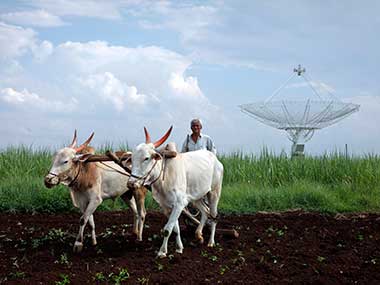Does agricultural analysis in India need a paradigm shift? Most analyses start and end with a portrayal of Indian farmers as helpless beings who will be doomed without the sympathies of the elite. However, today’s self-respecting farmer is basically a risk-taking entrepreneur, just like many of us. Thus, the approach to understand them cannot be that of patronage but of respect, dignity and empowerment—the same we have towards any other set of professionals or risk takers. This mindset warrants a focus towards taking all aspects of agriculture as a whole for policy response and not just some parts of it. Agriculture, like any other sector caters to two sets of stakeholders—producers and consumers. Given India’s demographics and history, about 50 percent Indians produce, while nearly 100 percent Indians consume agricultural goods and services. [caption id=“attachment_5636881” align=“alignleft” width=“380”]  Representational image. Reuters[/caption] On the production side, agriculture is the income source of a large section of Indian farmers. Farmers, like other entrepreneurs, need access to markets and credit along with mitigation mechanisms that offset external risks to run successful ventures. While a lot can be done to improve things on all these parameters, three policy interventions to drive structural change have seen superior execution, quality, and speed in the past few years. a) eNAM has integrated 585 markets across 16 states covering 114 commodities. A farmer can now sell produce through her cellphone to the mandi of her choice, thereby, matching demand and supply, b) Ambitious agricultural credit targets set by the government have been consistently exceeded; and c) Crop insurance to mitigate agri-risks has witnessed a new focus since 2016. Not only has coverage improved, but the claim process favors the farmers as insurance companies are now liable to pay strict penalties on account of delayed settlements. On the consumption side, agriculture is critical for food security. As per the UN Food and Agriculture Organisation, food security is achieved when “all people at all times have physical and economic access to sufficient, safe and nutritious foods to meet their dietary needs and food preferences for a healthy and active life”. Let’s break down this definition into parameters to measure India’s performance on food security. Two clear parameters are economic and physical access. Third is food sufficiency. ‘Safe and nutritious’ are difficult to measure as they are output-dependent. For instance, one may conclude that people have access to safe and nutritious food if health outcomes are good. But health also depends on other factors. So, for the purpose of this article, let’s focus on the three measurable criteria for food security-economic access, physical access and food sufficiency. One of the prime factors for widespread disenchantment with UPA-2 was price rise. Food comprises nearly 45 percent of the consumption basket and its prices matter especially to the millions still below poverty line. Food inflation averaged at 9 percent between 2006 and 2014 and reached a peak of 20 percent in 2009. Between July 2014 and November 2018, food inflation averaged at 4 percent. It is important to note that inflation compounds, thereby hurting the poor when it is high over a sustained period.
Just in terms of staple food—rice and wheat, inflation averaged at 4.5 percent between 2011 to 2014 and it came down to 1 percent between 2014 to 2017. The inference to draw here is that low levels of food inflation have greatly improved its affordability and hence, economic access to the poor.
The second parameter is physical access to food. This is again a tricky parameter to gauge, but essentially depends on the quality of infrastructure in the country and given India’s context—road, and rail matter a lot. Good infrastructure facilitates easy and quick transportation of food from one point to other. In this case, India’s north east deserves a special focus. Thanks to geography, terrain and slow-paced infrastructure development, physical access to food in this region has generally been difficult. In the last four years, more than 900 km of rail tracks in the north east have been converted into broad gauge and more than 20 new trains have been introduced. In terms of roads, the Union Government has sanctioned road projects worth Rs 1.9 lakh crores. Add to that the overall infrastructure push across the country and the problem of physical access to food appears minuscule. Finally, on food sufficiency, India has earned bragging rights. India’s food grain production stood at an all-time high of 285 million tonnes in 2017-18. Also, important to note that 2014-15 and 2015-16 were drought years and India still managed to produce food grain in excess of 250 million tonnes in both these years. Not just food grains, production of pulses that hovered around 13 million tonnes (between 1980s to 2000s) touched 24.5 million tonnes in 2017-18. The best service anyone can do to Indian agriculture is to analyse it objectively and fully. Do remember, even the greatest philosophers conceived that the earth is flat until they looked at the whole picture. (The writer is a public policy professional. Views expressed are personal) Follow full coverage of Union Budget 2019-20 here To keep watching India’s No. 1 English Business News Channel – CNBC-TV18, call your Cable or DTH Operator and ask for the Colors Family Pack (inclusive of 24 channels), available for Rs. 35/- per month, or subscribe to the channel for Rs. 4/- per day. To keep watching the Leader in Global Market & Business News – CNBC-TV18 Prime HD, call your Cable or DTH Operator and ask for the Colors Family HD Pack (inclusive of 25 channels), available for Rs. 50/- per month, or subscribe to the channel for Rs. 1/- per day.


)

)
)
)
)
)
)
)
)



